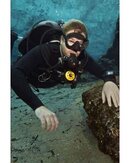I switched a few dives ago to using a necklace for my octo. I did it because I was constantly finding that no matter how I secured the thing it would come loose and dangle. Also, the hose just seemed to loop around me and contributed to me feeling cluttered. I route the hose under my arm, secure it with some bungee, and I hardly know it's there.
Well, the more I've read about this setup I've come to know I was doing a few things wrong. I understand that in a donation scenario I need to donate my primary and breathe octo myself. No problem - I've practiced breathing the octo several times (and replaced it as a result). I've also been reading that the primary should be extremely long.
1. How long should it be?
2. How should I route it so as not to reintroduce that "clutter" problem I'm trying to avoid.
For those of you who dive a setup like this, do you ever get a hard time from boat ops or divemasters regarding it? Any other potential problems I'm not immediately thinking of?
I ask because I'm finding my 8" dia steel tanks are more of a problem than I expected. I've never had to not dive, but they don't fit in most tank holders I've encountered so I have to do everything different from every other diver on the boat. I don't want to end up with another oddball configuration that doubles my trouble topside.
Well, the more I've read about this setup I've come to know I was doing a few things wrong. I understand that in a donation scenario I need to donate my primary and breathe octo myself. No problem - I've practiced breathing the octo several times (and replaced it as a result). I've also been reading that the primary should be extremely long.
1. How long should it be?
2. How should I route it so as not to reintroduce that "clutter" problem I'm trying to avoid.
For those of you who dive a setup like this, do you ever get a hard time from boat ops or divemasters regarding it? Any other potential problems I'm not immediately thinking of?
I ask because I'm finding my 8" dia steel tanks are more of a problem than I expected. I've never had to not dive, but they don't fit in most tank holders I've encountered so I have to do everything different from every other diver on the boat. I don't want to end up with another oddball configuration that doubles my trouble topside.




